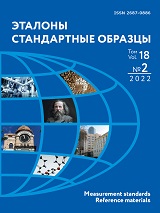
“Measurement Standards. Reference Materials” is a peer-reviewed scientific and technical journal with a thematic focus.
The mission of the journal is to provide an open platform for the exchange of scientific and applied information on the results of theoretical, experimental and applied research between researchers, scientists, engineers and developers, producers and users of metrological services in the interests of applied science. Free and open access to research results enhances the increase in global knowledge sharing.
The purpose of the journal is to accumulate scientific and technical knowledge and provide readers in Russia and abroad with open free information on current issues in the field of metrology and interdisciplinary sciences related to the development, implementation and application of standards of physical measurement units and reference materials for the composition and properties of substances and materials.
Sections of the journal
Measurement standards; Reference materials; Modern methods of analysis of substances and materials; Comparisons; Guidance materials. Regulations. Standards; Information. News. Events; Translations.
The target audience of the journal is researchers and laboratory analysis practitioners, university professors, postgraduate students, representatives of relevant business industries and those interested in metrology for the benefit of applied science.
Classification of articles
Review, scientific-theoretical, scientific-practical, analytical, scientific-journalistic, scientific-research articles. The journal accepts translations of articles published in foreign journals (with the consent of the copyright holder for translation and publication), as well as reviews, comments and reports on events.
Peer review
All scientific articles submitted to the journal's editorial board are subject to mandatory double anonymous (“blind”) peer review (the reviewer and the author do not know each other's names).
Journal output
Founder: D.I. Mendeleyev Institute for Metrology
Editorial office & Publisher: UNIIM – Affiliated Branch of the D.I. Mendeleyev Institute for Metrology
ISSN (print) 2687-0886
The publication is registered by Roskomnadzor.
Certificate of registration of the printed publication: PI No. FS 77-78423 dated May 29, 2020
Certificate of registration of the electronic publication: El No. FS 77-79330 dated October 9, 2020
Number of copies 200. The frequency of publication is 4 times a year
Distribution – Russia, foreign countries
Current issue
REFERENCE MATERIALS
MODERN METHODS OF ANALYSIS OF SUBSTANCES AND MATERIALS
ASPECTS OF MAINTAINING THE STATE REGISTER OF TYPE APPROVED REFERENCE MATERIALS
INFORMATION FOR AUTHORS AND READERS
Announcements
2020-06-29
Уважаемые коллеги, читатели!
Несомненно, 2020 год займет особое место в истории. Так уж совпало, что он стал поворотным и в жизни нашего издания. Теперь журнал будет выходить под новым названием «Эталоны. Стандартные образцы».
Для чего мы это сделали? Все просто: как и любой журнал, мы хотим расширить нашу аудиторию. Глобальная цель – приносить пользу большему кругу специалистов, занятых в метрологии и смежных отраслях теоретических и прикладных знаний, а также всем тем, для кого важны вопросы, связанные с разработкой и применением новых эталонов физических величин и стандартных образцов состава и свойств веществ.
В современном мире стремительно растет и усложняется парк средств измерений. Он требует адекватного метрологического обслуживания – с опорой на измерительные возможности, обеспечиваемые эталонной базой и постоянно наращиваемым арсеналом стандартных образцов. Необходимо стремиться к гармоничному сочетанию того и другого, особенно в тех областях, где качество и безопасность продукции определяются физическими, физико-химическими, технологическими, эксплуатационными и другими характеристиками веществ и материалов.
Претендуя на максимальное читательское внимание, мы выделили несколько ключевых рубрик, для которых будут готовиться публикации в журнале.
К печати будут приниматься, например, статьи, посвященные изысканию и использованию новых физических и химических эффектов для развития измерительных возможностей и метрологического обеспечения. Кроме того, на страницах издания мы будем сообщать о разработке и аттестации новых методик измерений состава и свойств веществ и материалов, равно как и о возможностях уже используемых методик и методов. Обязуемся информировать о результатах завершенных сличений при проверке компетентности испытательных и калибровочных лабораторий, при проведении межлабораторных сравнительных испытаний. Отдельная рубрика будет посвящена разбору новых или только планируемых нормативных документов, связанных с тематикой журнала. Наконец, в фокусе нашего внимания будет тематика создания, внедрения и совершенствования эталонов единиц величин, а также темы, связанные с разработкой, производством и применением стандартных образцов.
Искренне надеемся, что журнал будет приносить пользу специалистам, отвечающим за метрологическое обеспечение производства и испытаний продукции. Будем рады обратной связи, что позволит сделать наше издание еще более интересным и полезным!
Работаем для вас, коллеги, и открыты для сотрудничества!
Главный редактор журнала
директор
УНИИМ – филиала ФГУП «ВНИИМ им. Д. И. Менделеева»
С. В. Медведевских
Учредитель журнала,
генеральный директор
ФГУП «ВНИИМ им. Д. И. Менделеева»
А. Н. Пронин
| More Announcements... |

This work is licensed under a Creative Commons Attribution-NonCommercial 4.0 International (CC BY-NC 4.0).



































